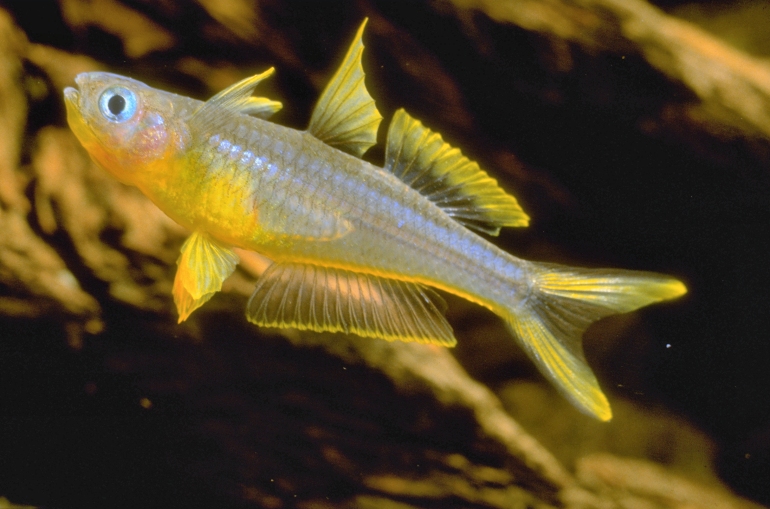|
 |
Pseudomugil furcatus - photo© Gunther Schmida |
Nichols, 1955
Forktail Blue-eye
Species Summary
Pseudomugil furcatus is a small species growing to a length of about 5 or 6 cm. They have two dorsal fins, separated by a small gap, the first much smaller than the second. The body colour is yellow-green in both males and females. The dorsal and anal fins of the males are transparent with narrow yellow margins. The pelvic and pectoral fins are often tinged with red. The caudal fin lobes are yellowish with black dorsal and ventral margins. Females caudal fin lobes are yellowish while the pectoral and pelvic fins are transparent. The outer part of the second dorsal fin is yellowish. The body scales have a slight dark edge. They differ from most other forms of Pseudomugil from Australia and New Guinea, in having the caudal fin longer and more deeply forked. Males are easily distinguished from females by their brighter colours and longer and more elongated dorsal fin.
Pseudomugil furcatus and Pseudomugil connieae are easily distinguished on the basis of colour and there are significant differences in modal counts for the second dorsal and anal fins. The most apparent differences involve fin colouration of mature males. The dorsal and anal fins of P. furcatus are mainly transparent to slightly dusky with a relatively narrow outer margin of yellow. Those of P. connieae have broad, whitish outer margins with a bold black band across the middle of each fin; the outer portion of the first dorsal fin is yellow as in P. furcatus. However, the caudal fin of P. furcatus has a pale yellow lobes with thin black dorsal and ventral margins, whereas that of P. connieae has whitish lobes, a dusty central portion, and lacks dark margins. The pelvic fins of P. connieae are largely dusky or blackish and the pectoral fins are whitish on the upper edge. By contrast the pelvics of male P. furcatus are yellow and this same colour is present on the upper edge of the pectoral fins. The females of P. connieae are basically similar to males except the dark bands in the middle of the dorsal and anal fins are less distinct and narrower, the outer edge of the second dorsal is broadly yellow (as in P. furcatus), the caudal fin lobes are yellowish and the pelvic and pectorals are uniformly transparent.
Distribution & Habitat
Pseudomugil furcatus were originally collected from Peria Creek, a tributary of the Kwagira (Kwagila) River, in eastern Papua New Guinea. They have also been collected from Safia, in the Musa River valley where they are relatively common in small, clear rainforest streams. They have a range in Papua New Guinea between Dyke Ackland and Collingwood Bays. They are generally found in small, clear, relatively swift-flowing freshwater streams with abundant aquatic vegetation. Water conditions reported from their natural habitats are: Temperature 24-28.5°C; pH 7.0-8.0 and Hardness 90-180 ppm.
Remarks
This species was originally named Pseudomugil furcatus in 1955 by John Treadwell Nichols, curator of recent fishes at the American Museum of Natural History. They were collected by Hobart M. Van Deusen during the Forth Archbold Expedition to New Guinea in 1953. In a review of the family Melanotaeniidae in 1980, they were separated from the Pseudomugil genus and placed in a new genus Popondetta, and the name was changed to Popondetta furcata. It was then later discovered that the genus name 'Popondetta' was previously used and in 1987 they underwent another name change and were then called Popondichthys furcatus. Two years were to pass and following a review of the Pseudomugil genus in 1989, the blue-eye group, including Popondichthys furcatus, were placed in their own family Pseudomugilidae and they were returned to their original name of Pseudomugil furcatus. In 1981 live specimens were collected by Gerald Allen and Barry Crockford and were returned to Australia whereupon they were later bred and established in the aquarium hobby.
Literature
Allen G.R. (1980) A Generic Classification of the Rainbowfishes (Family Melanotaeniidae). Records of the Western Australian Museum 8 (3): 449-490.
Allen G.R. (1981) Popondetta connieae, a new species of rainbowfish (Melanotaeniidae) from Papua New Guinea. Revue française d'Aquariologie 8 (2): 43-46.
Allen G.R. (1991) Field guide to the freshwater fishes of New Guinea. Christensen Research Institute, Madang, Papua New Guinea.
Crockford B. (1984) The genus Popondetta. Fishes of Sahul 2(2): 66-68.
Nichols J. T. (1955) Results of the Archbold expeditions. No. 71. Two new fresh-water fishes from New Guinea. American Museum Novitates 1735: 1-6.
Saeed B., W. Ivantsoff, and G. R. Allen (1989) Taxonomic revision of the family Pseudomugilidae (Order Atheriniformes). Australian Journal of Marine and Freshwater Research 40: 719-787.
Adrian R. Tappin
Updated August, 2015



|
|

